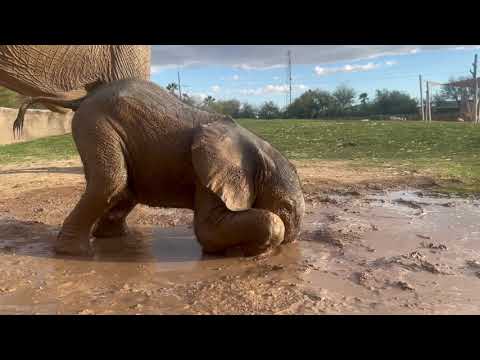– Understanding the behavior of elephant calves in their natural habitat and captivity
– The importance of mud baths for elephant skin care and thermoregulation
– Insights into zoo management practices for the care of elephants
– The role of wildlife conservation efforts in protecting elephants and their habitats
– Educating the public on the ecological significance of elephants through engaging content
Elephant calves enjoying mud baths are a delightful sight that captivates the attention of many, reflecting an important aspect of their overall well-being. Beyond their adorable appearance and playful antics, these activities serve multiple critical functions, from skincare to temperature control. This article aims to shed light on these behaviors, the care practices in zoo environments, and the broader implications for wildlife conservation, all while providing an engaging educational resource on these magnificent creatures.
Elephant calves, like their adult counterparts, indulge in mud baths to protect their sensitive skin from sunburn and parasites. The thick mud acts as a natural sunscreen and bug repellent, providing a protective layer that helps maintain healthy skin. Moreover, elephants lack sweat glands, so the mud plays a crucial role in thermoregulation, helping these large animals cool down during hot weather. This behavior underscores the elephant’s remarkable adaptability to its environment and highlights the critical need for habitats that support their natural behaviors.
Zoo management practices have evolved significantly over the years, emphasizing creating environments that mimic natural habitats. Modern zoos aim to provide elephant enclosures with access to mud baths, enabling them to exhibit natural behaviors crucial to their physical and mental health. These practices contribute to the elephants’ well-being and offer zoo visitors a glimpse into the natural behaviors of these fascinating animals, promoting a deeper understanding and appreciation for wildlife.
Wildlife conservation plays a vital role in ensuring the survival of elephant populations, which face numerous threats, including habitat destruction, poaching, and climate change. Conservation efforts often focus on protecting natural habitats and creating corridors that allow elephant migration, which is essential for their well-being and ecological role as mega-herbivores. By preserving these magnificent creatures and their environments, conservationists work to maintain the biodiversity that is critical for healthy ecosystems.
Educational content, such as videos of elephant calves enjoying mud baths, is a powerful tool for raising public awareness about the importance of elephants and their challenges. These engaging glimpses into the lives of elephants can inspire people to support conservation efforts. Highlighting the ecological significance of elephants, these educational efforts promote a broader understanding of the need to protect these animals and their habitats.
In addition to fostering an appreciation for elephants, such content can spark viewers’ curiosity about wildlife and conservation, encouraging them to learn more and potentially take action in support of conservation initiatives. Through education and engagement, the public plays a crucial role in the ongoing efforts to ensure elephants’ survival and preserve their natural environments.
Through the careful observation and study of elephant behavior, zoo management practices that prioritize animal welfare, and the dedicated efforts of wildlife conservationists, humans continue to deepen their understanding of these majestic creatures. By valuing and protecting elephants, humanity acknowledges the interconnectedness of all life and the importance of maintaining the health of our planet for future generations. Videos of elephant calves enjoying mud baths not only provide a moment of joy and wonder but also serve as a reminder of the responsibilities humans have toward wildlife and the natural world.
*****
Source Description
The Zoo’s elephant calf has started exploring mud! Mud baths are a great way for elephants to cool down and create a protective layer that helps shield them from the sun and protect them from bug bites 🐘☀️

